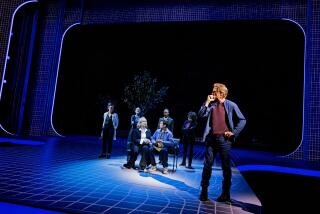A King-Size Challenge in Experimental ‘Lear’
In the most controversial moments of Robert Wilson’s unforgettable “Exploring ‘King Lear’ ” for UCLA Extension in 1985, his actors had to contend with an overlay of “King Lear” films and recordings dating back to the beginning of the century--all of them coming at once in a startling reminder of how our perceptions of classic theater are colored and sometimes deadened by every previous staging.
Experimental productions can shake us loose from our connoisseurship, demanding that we experience a classic as an unpredictable and even dangerous creation, and this is exactly the value of director Travis Preston’s audacious and intermittently revelatory modern-dress “King Lear” for the newly formed professional Center for New Theater at CalArts.
At the official opening on Friday, many of Preston’s innovations seemed willful, confusing and even ruinous, but just as many made you look at the play in a new light, from a different angle and with no shield between you and its uncompromising vision of human brutality. “King Lear” is never easy, but with its all-female cast, large-scale video projections and insistence that the audience follow the action from room to room, this version delivers one artful surprise after another.
It is performed in the imposing, 99-year-old Edison Electric Building at the Brewery Arts Complex near downtown L.A. Preston and set designer Christopher Barreca use its spatial possibilities resourcefully, emphasizing front-to-back action in the scene in which Lear divides his kingdom and then, after the audience and cast move to daughter Goneril’s domain, wide (lateral) action washed with oceanic video images designed by Christopher Kondek.
Circular paths dominate the most daring sequence--one in which the audience sits on risers looking at the play through a massive picture frame attached to the first row of seats. The actors come close to the frame, speaking directly to us, and suddenly the whole riser-unit swivels to follow them, rotating like a camera dolly to isolate certain characters. It’s “King Lear” reconceived as a living movie or hallucinatory theme-park ride, and it’s thrilling.
Obviously the production’s major shifts of scale impose unorthodox challenges on the cast, and many of the leads can’t stay in character when switching gears from intimate to declamatory acting. Nor does it help that Preston usually keeps them miles apart or facing away from one another in scenes where relationship issues should be deeply felt--Lear’s curse against Goneril, for instance, or his reunion with daughter Cordelia.
Stylistic inconsistencies also take their toll. This is a “King Lear” in which nobody actually opens a letter but instead holds it overhead and recites its contents. However all of the death scenes are staged with cornball literalism, and Preston’s interest in some major characters, but not others, wrecks the staging’s final hour.
Here we focus on the Gloucester-Edgar subplot, with nearly everyone else lined up against the back wall speaking into floor-microphones as if performing some semi-staged reading: the Reprise! “King Lear.” Because the room’s cavernous acoustic can’t clearly deliver all those amplified voices, the audience hears the whole resolution of the play over headsets--but the static staging and similarity of those voices frequently makes it impossible to guess who’s speaking.
Throughout this crucial arc of the play, Preston delivers not experimental or concept-driven Shakespeare or minimalist Shakespeare but a bewildering botch, complete with unfortunate cuts, large and small, in the adaptation by Royston Coppenger (everything from the chronology of the final battle to the line “Pray you, undo this button,” just before Lear’s death). So brush up your Shakespeare if you plan to go; Preston’s finale needs all the narrative clarity his audience can bring to it.
The final scene also unmans some of the strongest women--Mary Lou Rosato as Kent, for example, previously on top of the role but here hollowly punching out the words. Or Andrea LeBlanc and Tane Kawasaki, both boldly vicious as daughters Goneril and Regan but here creating no stir as they throw themselves at Edmund (the game, uneven Heather Ehlers) and die in agony.
Marissa Chibas keeps Edgar’s plight urgent through the character’s devious actions, and Sydney Slayden brings a distinctive heat to Cordelia’s speeches. But you have to know the Fool’s lines by heart to penetrate Elina Lowensohn’s accent in the role, and Joan MacIntosh finds no through-line as Gloucester; the performance remains a capably executed array of discontinuous effects.
As Lear, Fran Bennett gives a performance of authority and integrity in a narrow range--tetchy anger when banishing Cordelia, tetchy madness at Dover, tetchy vulnerability as life ends. There’s no unsure moment, and none suggesting greatness of soul. Her blunt fortitude may place her squarely in the Paul Scofield tradition, but she lacks the directorial support that made Scofield’s Lear belong to a superbly unified and persuasive worldview.
*
“King Lear,” the Brewery Arts Complex, 650 S. Avenue 21 at North Main, Los Angeles. Tuesday-Sunday, 8 p.m. Closes Sunday. $40. (877) 407-7499. Running time: 3 hours, 55 minutes.
Fran Bennett...King Lear
Joan MacIntosh...Gloucester
Mary Lou Rosato...Kent
Marissa Chibas...Edgar
Heather Ehlers...Edmund
Elina Lowensohn...Fool
Andrea LeBlanc...Goneril
Tane Kawasaki...Regan
Sydney Slayden...Cordelia
Elaine Tse...Cornwall
Gina Belafonte...Albany
Mandy Freund...Oswald
By William Shakespeare. Text adapted for performance by Royston Coppenger. Directed by Travis Preston. Scenic design by Christopher Barreca. Costumes by Ellen McCartney. Lighting by Christopher Akerlind. Sound by Jon Gottlieb and Leon Rothenberg. Video design by Christopher Kondek. Choreography by Rica Blunck. Original music by Vinny Golia. Car wreck sculpture by Michael Casselli. Technical direction by Bill Ballou. Production stage manager: J.P. Elins. Center for New Theater at CalArts, Susan Solt, producer/artistic director. Travis Preston, producing director. Carol Bixler, co-producer. Associate producer: Leslie Tamaribuchi.
More to Read
The biggest entertainment stories
Get our big stories about Hollywood, film, television, music, arts, culture and more right in your inbox as soon as they publish.
You may occasionally receive promotional content from the Los Angeles Times.










